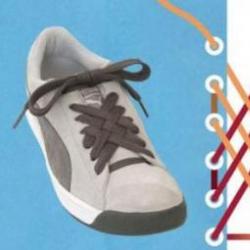How to cut men's jeans beautifully. How to beautifully cut jeans yourself? Tools for making holes
- Light soap for marking. The marks disappear after washing.
- Plywood, thick cardboard or kitchen board.
- Stationery knife.
- Tweezers.
General logic
It is better not to tear the jeans, but to cut them, otherwise, when torn, the hole may go diagonally. It is necessary to cut strictly horizontally so that more white threads remain intact. Over time, the hole will increase, cut with reserve. If you make several holes side by side, they will quickly become one big one. The hole in your knee will stretch so big in a month that a dove will fly into it, and you won’t even notice.
Technology
✭ Stick a piece of plywood or cardboard into your pant leg so you don’t cut right through.
✭ Mark the future contours of the hole with dry soap.
✭ Imagine you are removing the appendix of your jeans and make the cut in one quick motion. If you want a larger hole, make several parallel cuts every 1-2 cm.
✭ Use tweezers to pull out several horizontal threads from above and below. With the same tool, draw out the vertical threads, remove the dark threads, and light fluffs - you will get a fringe. Decide whether to leave the white horizontal grain or trim it to create a gap through it.
✭ Go over the edges of the hole with sandpaper - this will give it a more natural look.
✭ Finally, you can apply a little bleach and leave for about ten minutes. But this is at your own peril and risk: the effect can be unpredictable.
✭ Sew a patch of fabric to the inside of the hole in the color of your jeans, if the designer in you is still in agony. Give him a chance. The holey effect will remain, but in winter your feet will not be covered with snow.
When a trend that was forgotten by everyone for a while returns, its new success always eclipses the previous one. The last time the hype around ripped jeans flared up was in the late nineties and early 2000s. He slept quickly, and some did not have time to dare to purchase a strange new product. A couple of years ago, designers remembered this stylish move, and since then, almost every new collection has a place for artificially aged and cut jeans.


The stores offer a large selection of trendy pants. But turning ordinary denim trousers into trendy ones is much more interesting on your own. Moreover, it is very simple! We'll tell you how to cut jeans beautifully.

Which jeans are better for making cuts?
In this matter, two factors are important - the style and material of the jeans. The first one is determined quite easily.
Choose a model that will fit you perfectly and highlight all the advantages of your figure. At the same time, the pants should not be too loose.
It is also not acceptable for them to be tight and literally bursting at the seams.



With the choice of fabric the situation is more serious. Not every jeans with rips looks or wears equally well. There are fabrics that absolutely cannot be “shredded”. For example, those made from fleece.
This option will not look aesthetically pleasing; moreover, during the first wash, the fabric in the area of the cuts will spread in all directions.

You should opt for medium-density fabrics. It can be “dry denim” (Raw denim) or “gin” denim material.

If your goal is to give a second life to old, worn-out jeans, then, of course, you won’t have a choice here. Experiment with what you have.
Try making small cuts and see how they look when worn and how they change after washing. And if all goes well, you will be lucky: instead of a discarded pair of old trousers, you will receive an updated and trendy item.



Where are the holes made?
The most popular place for cuts and holes on jeans is the knee area. Scuffs from the knee to mid-thigh also look good. There are also interesting options for the entire length of the trouser leg.
But in this case, neat cuts look most advantageous. As a rule, the front part of the trouser leg has holes.




Fans of extreme style will like the option with a cut out fragment. It can be done on one of the legs.
The location is selected individually, depending on your desire. As well as the shape, which can be standard (rectangular, square), or maybe unusual (heart, flower, star).

To mark the locations of future holes and cuts on the jeans, they need to be placed on a hanger. When the pants are in a suspended state, you should make marks on them with chalk or soap (on white jeans you can use a soft pencil). Mark the lines of future cuts carefully, with thin strokes.

If you plan to make several cuts, calculate the distance between them so that they are 2-3 centimeters from each other. When the marks are made, evaluate the picture from the outside.



To finally make sure that the planned fashionable touches will be in place, you need to try on jeans with these sketches. You can try to outline different options and compare them. After several fittings, you can confidently choose the optimal number and location of holes on your jeans.

How to make cuts correctly?
There are several simple, but very important nuances that will help you make the right cuts on your jeans:
- To make perfect cuts, arm yourself with a utility knife. It, unlike scissors or a kitchen knife, guarantees accuracy and ease of the process.
- Before you start making cuts and holes, place a metal or wooden strip (for example, a wide ruler) under the “operated” side of the pant leg. This will protect the back of the pant leg from unwanted damage.
- Cut exclusively in a horizontal direction. This is important because any denim fabric is loose in its weave structure. If you cut at an angle, you risk losing control of the decorative element you are making. It may turn out completely different from what you want.



How to properly rip jeans at the knees?
To create stylish knee holes, you will also need the following tools:
- clothes brush with hard bristles;
- nail file (metal), maybe a small file;
- a thin sheet of sandpaper;
- pumice stone or a fine kitchen grater.

All this equipment will help you easily achieve the effect of antiquity. Holes made with it will look stylish and original. When all the tools are prepared, you can get down to business!

- Place the strip under the place on the jeans where you plan to make the cut.
- Smoothly, but with strong pressure, cut the intended place.
- From the resulting cut, pull out several threads in a longitudinal direction, cut on both sides.
- Next comes the design of the resulting cuts. Straighten your jeans. Carefully brush the fabric along the edges of the cuts to fray the vertical threads.
- The next manipulation is finishing the edges with a nail file. In this case, you need to straighten all the ends of the threads outward. After this stage, the cuts, as a rule, still have a very neat appearance. This is fine.
- Final touches - make a few decisive strokes with a pumice stone, sandpaper or fine grater along the edges of the cuts. The resulting fringe will become thinner and more delicate.
- Try on the jeans and evaluate the result of the work done from the outside. If you want to add more cuts, do so. If everything suits you, then it’s time to throw the jeans in the mirror. To your complete satisfaction, put the jeans in the washing machine. There the slots will take on their finished appearance.



Ripped jeans continue their victorious march around the world, conquering everyone on their way: women and men, businesswomen and DIY lovers, show business stars and schoolgirls...
Everything is torn: flared jeans, skinny jeans, old-school banana jeans, boyfriend jeans - the fashion trend knows no limits!
Today, frayed and torn jeans are presented in the clothing lines of the most famous and most popular brands, and on the Internet they even offer to rip jeans to order (I, for example, found a whole group of ripped jeans fans on social networks), but we suggest you arrange your own fashion reprisal jeans!
How to tear jeans so that they look beautiful and don’t fall apart? What holes in jeans visually spoil your figure? How to make scuffs on jeans? If jeans are torn or frayed during wear, how can you stylishly revive them? What else can you do to upgrade ripped jeans? We have collected the most interesting ideas for you and, of course, many, many photos.



How to rip jeans at home
It happens that the desire to tear and throw (creatively, of course!) causes you to have specific jeans: they are too bland, the model is outdated, or the jeans were torn without your consent and now they need to be saved. But if you haven’t decided which jeans to remake, or maybe you’re just going to look for the perfect pair at the nearest second-hand store (by the way, I advise you to take the “first pancake” from this storehouse of clothes for DIY alterations), take a few simple tips:
- It is better to take jeans that are not too loose and not too tight;
- the most aesthetically pleasing (contrast of threads) tear is classic blue or blue denim;
- The currently popular elastic jeggings are unlikely to be torn beautifully if they have an elastane base (just look at the inside).

How to cut jeans: photos, instructions
In addition to the jeans themselves, we will need simple tools: a utility knife, a bottle or a piece of wood (put it inside so as not to inadvertently cut through the entire pant leg), nail scissors, a needle or pin. If you want to give the cuts a slight fraying and disheveled look (we will describe in detail how to beautifully rub jeans below), a pumice stone, a nail file, a stiff brush or a piece of sandpaper will also come in handy.
Measure seven times... Estimate by eye, or better yet, mark the boundaries of future cuts with chalk or a piece of soap. In order not to miss, put the jeans on yourself - this way you will be sure that the holes will be in the right places.
Remember that holes in jeans will attract the attention of others. If you are the owner of an appetizing figure, you should not make cuts on the “soft places”; limit yourself to neat cuts just above and below the knee. Elongated narrow holes along the central axis of the legs visually lengthen and slim the knives. Wide, torn holes just below the pockets will visually increase the hips.

...cut once. How to cut jeans so that you don’t regret it later? If you cut it hastily, you risk getting jeans that look untidy and even vulgar. Therefore, stock up on time and patience. It is better to start with a small incision, enlarging it if necessary.
If you decide to rip your jeans for the first time, it's a good idea to master the technique of separating the fibers from a piece of old denim.

So how do you rip jeans?
1. After we have marked where we will make the holes, we spread the jeans on a flat surface. We place a board under the cut site or insert a bottle into the pant leg (so as not to cut through the back) and use a utility knife (you can use a blade, but be careful) to make a neat cut. We cut strictly horizontally (take a closer look at the structure of the denim and move the knife along the transverse threads). A cut at an angle will damage the light threads, which as a result should cover our hole.
2. If you need a small hole-slit, carefully use tweezers so as not to tear it, release the light threads (this is where a needle comes in handy), tousle the blue ones with an old toothbrush; if they are too long, cut them.
3. If you want to make a bigger hole in your jeans, make a horizontal cut of the required length and parallel to it (a couple of centimeters higher or lower) another one. Place your fingers under the resulting loop and use tweezers to pull out the blue threads. In this way, you can make holes of different sizes on jeans, gradually increasing them, but do not overdo it.

Try on your jeans regularly to make sure everything goes according to plan. You can add fraying and grunge using a brush (walk along the contour of the cut) and bleach (apply along the contour and leave for half an hour), if everything suits you, put the jeans in the washing machine, it will give your ripped jeans a finished look.
If you decide to make a figured hole on your jeans, do not forget to secure the edges with non-woven fabric (from the inside) or sew along the contour, otherwise the figure will spread out during the first wash.
How to tear the knees of jeans
Noodle jeans (jeans with many parallel slits) have already become boring to me personally (excuse me, “noodle” fans!), but jeans with even slits at the knees are now at the peak of popularity.
If you want a large hole at the knees with white cross threads, use the method described above.

For example, I’m not ready to focus attention on my knees (and in the case of jeans that are severely torn at the knees, this will be the case), so I was more attracted to straight holes and slits.
Making them couldn’t be easier: put on jeans, draw a straight line on your knees with soap, take off the jeans and make a cut.

Here you can no longer monitor the smooth movements of the knife and, on the contrary, cut in jerks. Personally, I especially like black jeans with ripped knees, what about you?
By the way, the other day I met a guy on the street whose jeans had holes... on the inside of his knees! Unfortunately, I didn't have time to take a photo... ;)
How to make distressed jeans
Jeans are probably the only thing in a modern girl’s wardrobe that is deliberately given a “killed” look. Scuffs and slight fraying on the jeans will be a great addition to the holes that we have already made earlier. By the way, the idea of artificially aging jeans is not new; back in the 80s, our parents experimented with their jeans: they rubbed them with a grater, sand and bricks, hit them with stones, washed them in salt water and tea (for a rusty tint). I recommend using pumice or sandpaper.

How to make scuffs on jeans yourself
Yes, yes, pumice and sandpaper! And judging by the price tags for distressed jeans in stores, you can’t say that everything is so simple, right?
So, we proceed according to the already familiar scheme: we mark the areas where we will make abrasions, only we take not a knife, but a pumice stone, and begin to rub. If you want to make minor scuffs, you can even use a rough nail file.

To further lighten worn areas on jeans, use bleach (wet the desired areas and leave for 20 minutes).
If you want full grunge – both holes and scuffs, then it’s better to rub your jeans first and then tear them.
Don’t overdo it: if the fabric under the pumice gets too thin and tears, you won’t get a nice hole, you’ll have to make a patch... We’ll talk about how to creatively patch jeans below.
Jeans are frayed: we save them beautifully
If your jeans fray when worn (along the crotch seam, on the inside of the thighs; for example, my jeans always rub in the folds under the knee), you can try returning them to your wardrobe!
There are several options for how to revive worn jeans: make a patch, appliqué, stitch thickly, or, if the place is suitable, make the wear stylish, a la “as intended.”
It is better to work with slightly damp jeans: textile dust will spread much less.
How to alter jeans
Ripping jeans and making scuffs are the simplest options for upgrading tired jeans. I’m sure that as soon as you see how your jeans will be transformed by these simple alterations, your hands will be itching to add something else.
Be careful, you may end up with a real designer piece using the following ideas! ;)
How to repurpose old jeans
If you are still ready to serve, but are already bored with your jeans, a makeover is inevitable!
I suggest playing with different variations of patches and linings: denim in a contrasting color, coarse cotton with an interesting print, leather, lace.

All the techniques are ideal for remaking jeans with defects: you can “hide” both a stain and a hole!

I would especially like to note the “hole+colored patch+elements of simple embroidery” technique. By the way, you can save holey jeans! This alteration of old jeans will take you no more than half an hour.
Jeans should not be too narrow or wide.
Ripped jeans are coming back into fashion; it would seem that they were already forgotten back in the nineties. But, as we know, fashion is cyclical, and once again famous couturiers bring models to the catwalk wearing jeans with scuffs and holes.
These jeans have become a real hit this season. If you want to be known as a real fashionista, you should definitely have at least one such stylish thing in your wardrobe.
There is no need to buy expensive ripped jeans, especially since they are not cheap. It is quite possible to turn old jeans into a real fashionable masterpiece.

To do this, choose the right jeans. They should not be too narrow or wide. Because the finished cuts on skinny jeans will stretch even more, and on wide ones they will become completely invisible. So, the jeans have been chosen. What else do you need? Take a sharp utility knife, scissors and chalk.
We will need chalk at the very beginning stage. Hang the jeans on a hanger, mark where the cuts will be, they should be symmetrical and not very close to each other, because the denim can crumble over time and instead of neat cuts you will end up with a huge hole that will not make the product attractive. Mark the places of the cuts with chalk, then look at the jeans from the side, moving a few meters away from them. If you are satisfied with everything, proceed to further work.

It is worth noting that quite large slits will be fashionable in the new season. However, before you do them, be critical of your external data; if your legs and butt are far from ideal, you should not emphasize your shortcomings. Make neat cuts that will not draw attention to problem areas.
- So, everything is ready to transform your old jeans. Take a sharp utility knife and make cuts of the required size. You should be cutting, not tearing. Denim fabric tends to quickly fall apart when it rips, and a large hole usually appears at the tear site, which only grows over time. We don’t need this effect at all, since we are making a beautiful, designer thing.
- Then you need to fray the edges of the resulting holes and pull out a little extra thread. This usually results in a two-tone effect since denim is always lighter on the inside.
- If you end up with hanging threads that are too long, be sure to cut them, otherwise it will look completely sloppy.
- The threads around the cuts can be thoroughly ruffled and combed with a wide comb, then you will get a more “fluffy” version.
- You can also rub the hole a little and then the effect will be different - shabby. This feature is also in fashion today.

In addition, you can make not only longitudinal cuts; experiment, make stars, hearts and other shapes. They can also be beautifully frayed around the edges, making them look very original and fresh.
To begin with, make very few cuts and try them on, because the fabric will stretch on the body and the holes will become more noticeable. And you can always add a couple more cuts, but there’s no way to remove them. So don't rush, take more time, get creative, and you'll end up with chic ripped jeans, no worse than those from famous designers.
So, you finished the job, tried it on and were satisfied with the result. Then rinse the finished jeans in cold water and dry. Then iron it and you can wear it with great pleasure!

Ripped jeans - style
It should be said that when wearing such jeans, be sure to do hair removal. Otherwise, your legs, which are visible in the slits on your jeans, will not look aesthetically pleasing at all. Pay attention to the choice of underwear, it must be suitable.
Also think about what clothes you'll wear with your ripped jeans. It is very important that your image looks like a single, harmonious ensemble. A great option is T-shirts, tops, shirts tied in a knot, denim jackets. Designers and stylists offer complete freedom of choice when it comes to footwear - these can be boots, over the knee boots, sneakers or high-heeled shoes.












How to make ripped jeans? Video
As you can see, having spent very little time, you could easily create a stylish basis for a fashionable wardrobe!
The fashion for ripped jeans is not something strange: it is an echo of the country style, in which abrasions, protruding threads and large holes are common. You can easily turn simple jeans into stylish ones at home. Instead of buying designer masterpieces at exorbitant prices, it is enough to use scissors and tweezers correctly.
Preparation
To make ripped jeans, you need to stock up on these tools:
- fabric scissors, knife or blade;
- sandpaper, grater, pumice - to create abrasions;
- tweezers for pulling threads;
- chalk or a piece of soap for marking.
Experimenting with scuffs and holes is not suitable for all models. Tight and stretchy trousers are unlikely to be torn beautifully. Holes and threads will make straight and wide-leg jeans more stylish.

Where to begin
To properly rip your jeans, you should first mark them. It is better to draw areas of future decor with chalk. It wipes off easily after work and will be noticeable during it. Before marking, put on your pants: this will make it easier to choose the final processing location. Another marking option is to place thick cardboard or something hard and flat under the trouser leg.
The hole can be any size, and the most common places are the hips and knees. In the latter case, the marking for the incision is placed just above the joint.
Advice! If the jeans are old, it is better to make small cuts and avoid places where there are bends. New jeans can be torn in all directions - their material is still quite strong.

How to rip jeans
How to make ripped jeans correctly:
- It is recommended to make cuts slightly smaller than the markings so as not to accidentally damage the product.
- It is convenient to cut jeans according to the markings, folding them in half at the intended center of the cut.
- To create holes and protruding threads, two parallel cuts are made with an interval of 5 mm. Using tweezers, the transverse threads are pulled out. Only the longitudinal ones remain. If you make several cuts, the hole will be larger. The length of the cuts does not have to be the same - different ones will make the decor more interesting.

- The threads look very impressive, but there is no need to leave them all. Some holes in jeans look good without threads. You just need to trim the edge.
- To create abrasion, the fabric is treated with sandpaper, a grater or pumice. You can even try a nail file. The fringe is made along the edges of the cuts, while trying not to damage the transverse or lobar threads.
- You can also get a fluffy edge using tweezers: you need to pull several threads with it.
- To make the legs appear long, the incisions are placed vertically, randomly and sparingly.

Advice! Washing in hot water with an aggressive powder will help give your jeans a worn look. And the “burnt-out effect” is achieved with a bleach solution. The liquid is applied with a piece of cotton wool or cloth. After treatment, the product is washed immediately, as the substance can eat through the fabric.
A little courage, accuracy and imagination - and your ordinary jeans become a stylish, exclusive item.






